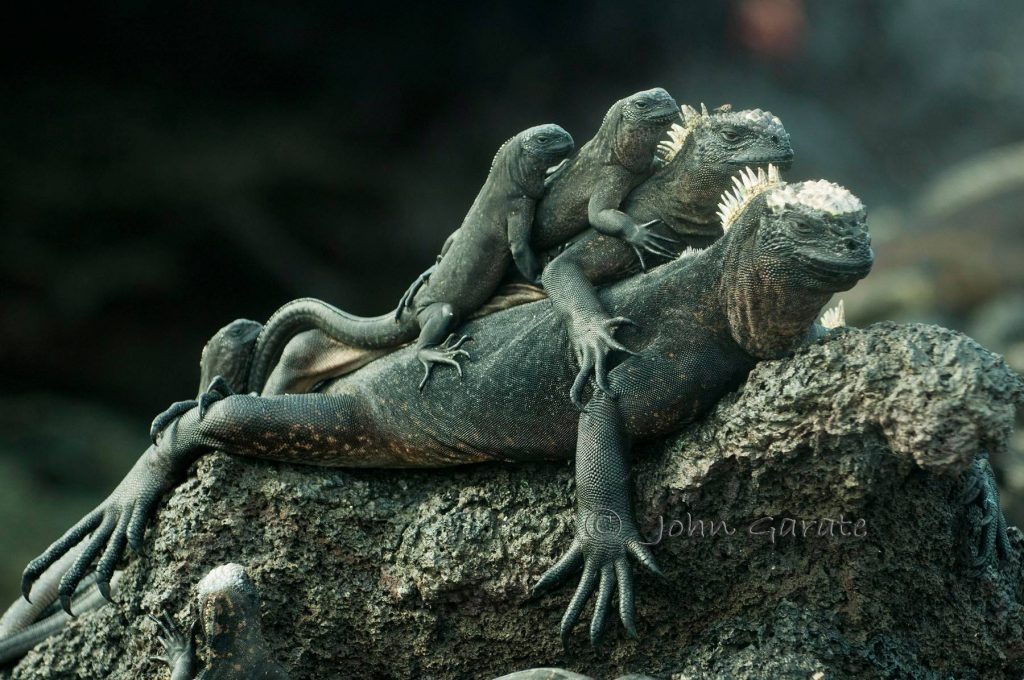
Lookout, don’t step on the Marine Iguana!
That’s right, strolling along the streets, and on the beaches in the Galapagos Islands, you need to watch where you step when the Marine Iguanas are sunbathing or cooling down in the shade. The Galapagos Islands are the only place on earth where you will find Marine Iguanas. The Galapagos Marine Iguana is a reptile and they regulate their body temperature basking in the equatorial sun and resting in the shade. As you walk down Charles Darwin Ave on the black lava sidewalk look where you are walking, because you are in the Marine Iguana territory. You will also find the Galapagos Marine Iguana wondering on the beaches and swimming in the bays.
The unique Marine Iguanas feed on algae that grow in the ocean. These sea-going creatures not only feed in the shallows along the rocks, but they also dive in the depths and feed. They can hold their breath for more than 30 minutes. In addition, they can also drink salt water and have the ability to excrete salt. You may see them “spiting salt”. The process of spiting salt gives the Marine Iguana a white haze on their heads.
The Marine Iguanas are black, but the large breeding males become very colorful. The males put on their best to impress. During mating season they show brilliant reds and greens.
The Marine Iguanas share a common ancestor with the Galapagos Land Iguana that most likely floated to the Galapagos Islands. The Galapagos Marine Iguana has been in the Galapagos Islands for over 8 million years.
The Galapagos Islands are home to eleven different subspecies of Marine Iguanas. In 2017, the first comprehensive taxonomic review of the species in more than 50 years resulted in new findings. Based on morphological and genetic evidence, there is now recognition of five new subspecies. Come and experience these unique creatures.
A. c. cristatus Bell, 1825 (albermarlensis and ater are a junior synonyms) – Isabela and Fernandina Islands
A. c. godzilla Miralles et al., 2017 – northeastern part of San Cristóbal Island
A. c. hassi Eibl-Eibesfeldt, 1962 – Santa Cruz Island and smaller adjacent islands such as Baltra
A. c. hayampi Miralles et al., 2017 – Marchena Island
A. c. jeffreysi Miralles et al., 2017 – Wolf, Darwin and Roca Redonda islands
A. c. mertensi Eibl-Eibesfeldt, 1962 – southwestern part of San Cristóbal Island
A. c. nanus Garman, 1892 – Genovesa Island
A. c. sielmanni Eibl-Eibesfeldt, 1962 – Pinta Island
A. c. trillmichi Miralles et al., 2017 – Santa Fé Island
A. c. venustissimus Eibl-Eibesfeldt, 1956 – Española (including adjacent tiny Gardener Island) and Floreana Islands
- c. wikelskii Miralles et al., 2017 – Santiago Island and smaller nearby islands such as Rábida
Donna Daugherty is a long time permanent resident of the Galapagos Islands. She has worked as a consultant for the Charles Darwin Foundation and is a founding member of Ambiente Independiente. She is an entrepreneur owning and developing businesses for over 20 years. The owner of Torre Mar Galapagos Apartment Hotel serving guests in Galapagos.
